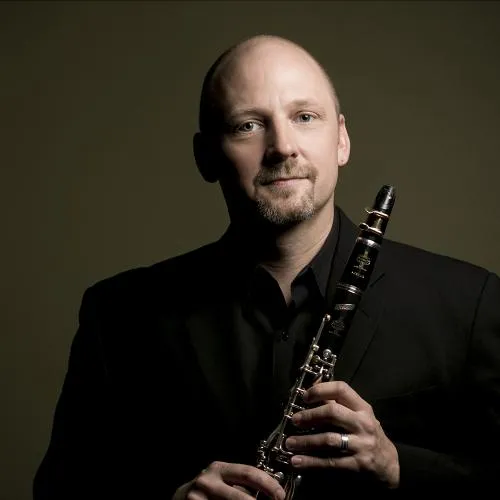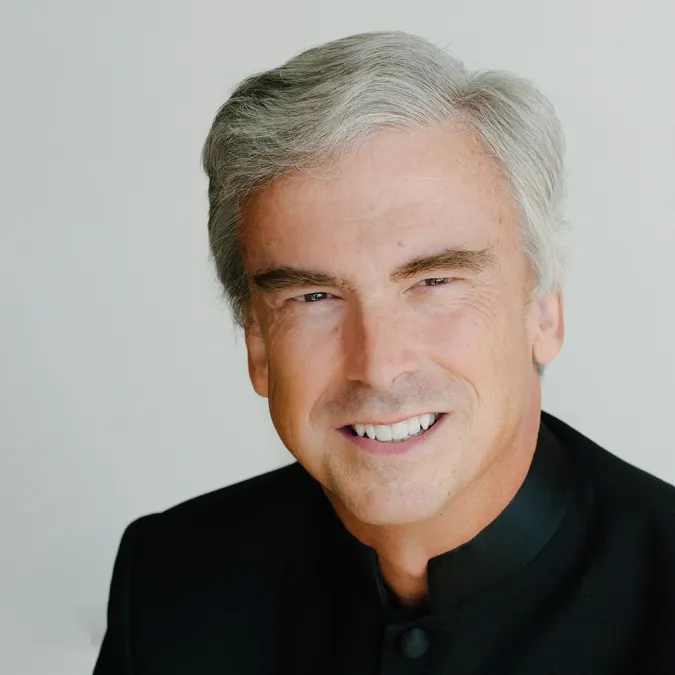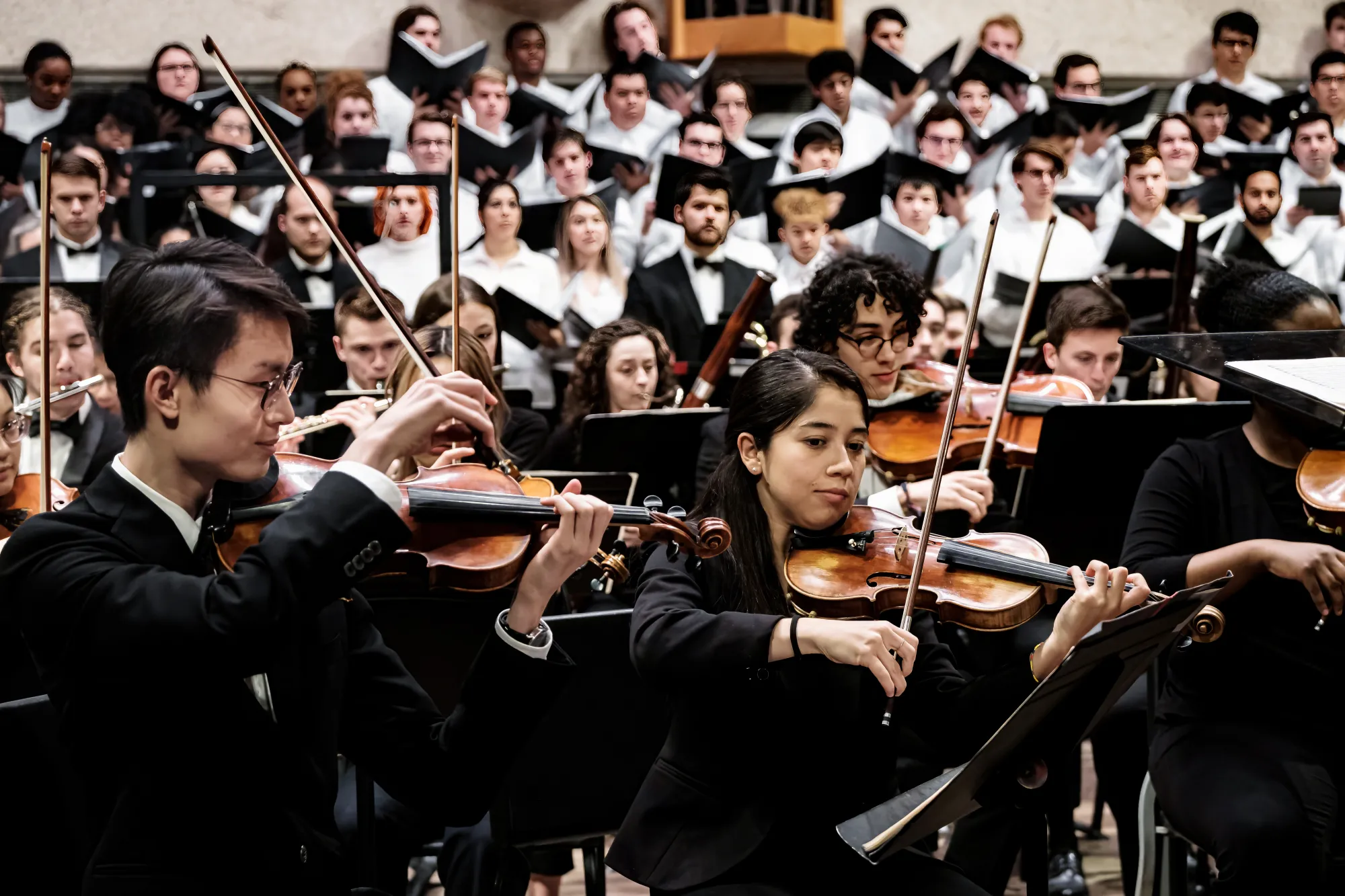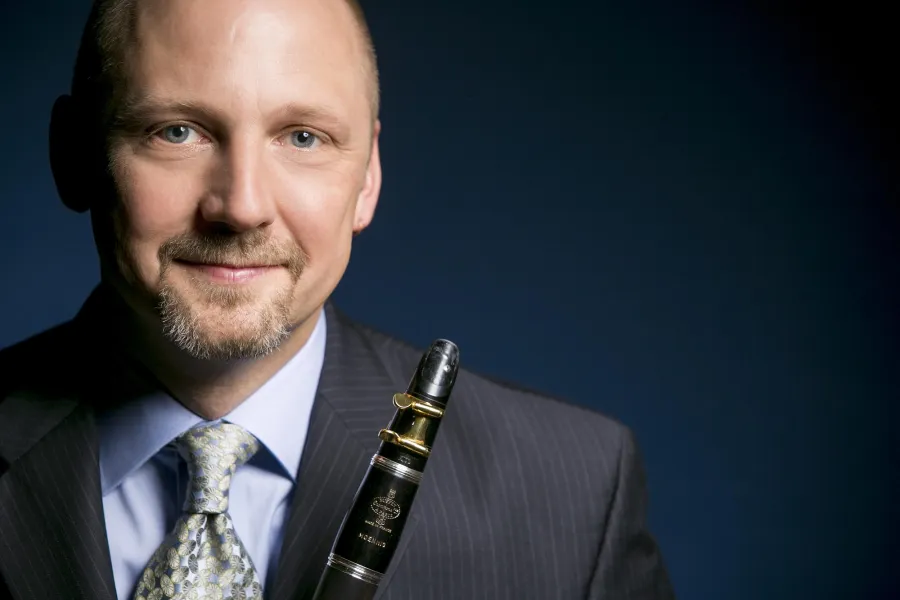Jerry Junkin, conductor
Jonathan Gunn, clarinet
This concert will last about 90 minutes with one intermission.
Please silence your electronic devices.
Photography, video, or recording of any part of this performance is prohibited
Program
Richard Strauss
arr. Levick / Shaffer
Festival Intrada
W.A. Mozart
Concerto for Clarinet, K. 622
trans. Rumbelow
Allegro
Adagio
Allegro
Jonathan Gunn, Clarinet
intermission
Michael Martin
Lontano: Symphony for Wind Ensemble
In the void, alone
The Void
Alone
Glow
Sunrise
Terror
Orb
Immersion
The Void
Alone
Interlude: Spiral
Horizon
About the Program
Program notes by Mark Bilyeu
Richard Strauss
Feierlicher Einzug der Ritter des Johanniter-Ordens
Born June 11, 1864, Munich, Germany
Died September 8, 1949, Garmisch-Partenkirchen, Germany
Composed 1909
Duration 8 minutes
Feierlicher Einzug der Ritter des Johanniter-Ordens (“Solemn Entrance of the Knights of the Order of Saint John”) was written in 1909 by Richard Strauss, in the prime of his career. Commissioned by the Knights of St. John, the music was intended for their investiture ceremony. The organization was founded as a Christian military order in Jerusalem in 1023 to care for poor, sick, or injured pilgrims journeying to the Holy Land; today, offshoots of this order still exist, doing charitable works — primarily in aiding the poor and the sick — around the world. Strauss originally scored this work for 15 trumpets, four horns, four trombones, two tubas, and timpani. After its initial success, he later scored the work for a full orchestra, including organ and optional chorus.
Wolfgang Amadeus Mozart
Clarinet Concerto in A Major, K. 622
Born January 27, 1756 in Salzburg, Austria
Died December 5, 1791 in Vienna, Austria
Composed October 1791
Premiered October 16, 1791, Prague, Anton Stadler, clarinettist
Duration 30 minutes
It’s nearly impossible to imagine, but in 1791, the music of Mozart was falling out of fashion (the Viennese public has always been notoriously fickle). A costly war with Turkey had deeply affected Austria’s reactionary King Leopold II, who decreed a state - wide ban on the freedom of expression, zapping the joy out of concertgoers across the land. While Mozart’s commissions began drying up, his creative genius continued flowing, and, in what would be the last year of his life, he wrote a piano concerto, the String Quintet in E-flat, and two full operas — Die Zauberflöte and La clemenza di Tito. Alongside these works, he wrote a concerto for his friend, the clarinettist Anton Stadler. Stadler was not only a virtuoso clarinettist — Mozart had already written his Trio for Viola, Clarinet, and Piano, and the Quintet K. 581 for him — he was also the inventor of an instrument called the basset clarinet, which extended the standard clarinet’s lower range by a third. Mozart completed the three-movement work in October, and it’s believed that Stadler (already in Vienna playing the basset clarinet for the premiere of Clemeza) premiered the concerto later that month. Although the work has a typical three-movement structure of fast-slow-fast, the unifying theme of the work is one of calm lyricism rather than virtuosic prowess (although the technical demands are still present). Listen for the ways Mozart exploits the full range of the instrument, and how he crafts a dialogue between the soloist and the ensemble. The work was never published for the basset clarinet, rather, arrangements were made which allowed for the standard clarinet to share the beauty of one of Mozart’s last works.
Michael Martin
Lontano: Symphony for Wind Ensemble
Born 1985, Marietta, GA
Composed 2016
Premiered May 22, 2016, Northwestern University Symphonic Wind Ensemble, Mallory Thompson, conductor
Duration 24 minutes
Michael Martin’s Lontano was commissioned by Mallory Thompson and the Northwestern University Symphonic Wind Ensemble in celebration of Thompson's 20th anniversary as director of bands at Northwestern University. Her request was that the work honor both the hundreds of students she worked with throughout her career, and additionally her trumpet-teacher-turned-Northwestern-colleage, the late Vincent Cichowicz. What resulted was what Martin described as a work “huge in scale,” intended to speak not just to the performers at Northwestern, but to those who would listen to his work, as well. In the composer’s own program note, he writes
“Lontano is an Italian word meaning “at or from a great distance,” often used in a musical context to describe something intended to be played extremely quietly or very distantly offstage. In the case of this piece, the title is certainly representative of the use of both musical devices, but is intended more to describe a musical range and scope in a context that is subjective to the listener. The movement titles, and individual ‘chapters’ listed within the first movement, are intended to depict a somewhat visceral and narrative representation of grief, whose process is at once unique and common to us all. The analogy is that of floating through complete blackness, becoming immersed in a massive orb of light, being flung violently back into the dark, spiraling out of control, and eventually arriving at a collection of the most beautiful horizons we could imagine.”
About the Artists
Jonathan Gunn

Clarinetist Jonathan Gunn is a versatile artist with a varied career as educator, soloist, chamber musician, and orchestral performer. He was associate principal and E-flat clarinet of the Cincinnati Symphony Orchestra from 2004 to 2011, and served as principal until 2016. Gunn has also performed as guest principal clarinet with the Chicago Symphony Orchestra and Houston Grand Opera as well as a guest with the New York Philharmonic and Pittsburgh Symphony. Gunn has performed at music festivals including Tanglewood, Aspen, St. Bart’s, Sunflower, and Buzzard’s Bay. As a soloist, he has appeared with the Cincinnati Pops Orchestra, the Fort Wayne Philharmonic, and around the world. Recently, he recorded the Corigliano Clarinet Concerto with The University of Texas Wind Ensemble for Reference Recordings. Mr. Gunn gives masterclasses and recitals internationally, and has served on the faculties of the Buffet-Crampon Summer Academy, the Aria International Summer Academy, the National Youth Orchestra of the USA and Round Top Music Festival. Gunn is a D’Addario Artist and Musician Advisor, and a Buffet Group USA Performing Artist.
jonathangunnclarinet.com
Jerry Junkin

Serving since 1988 on the faculty of The University of Texas at Austin, where he holds the Vincent R. and Jane D. DiNino Chair for the Director of Bands, in addition to serving as a University Distinguished Teaching Professor, Jerry Junkin is recognized as one of the world’s most highly regarded wind conductors. Previously, he served on the faculties of both the University of Michigan and the University of South Florida. In addition to his responsibilities as professor of music and conductor of the Texas Wind Ensemble, he serves as head of the conducting division and teaches courses in conducting and wind band literature. He has served as music director and conductor of the Hong Kong Wind Philharmonia since 2003, and as artistic director and conductor of the Dallas Winds since 1993. He also serves as visiting professor at the Senzoku Gakuen College of Music Wind Ensemble in Tokyo, Japan. Mr. Junkin has conducted All-State bands and festivals in forty-eight states and five continents, and is a Yamaha master educator.
Wind Ensemble
Flute
Diego Arias
Riley Bender
Kyndahl Britton
David Ma
Subin Oh
Oboe
Genevieve Britten
Ryan Hirokawa
Zane Laijas
Ella Shank
Clarinet
Andrew Battaglia
Sarah Darragh
Connor Gibson
John Hill
Sadie Murray
Katelyn Nguyen
Kaitlyn Nohara
Mason Smith
Alexander Vaquerizo
Bassoon
Mallory Mahoney
Isabella Perez
Mario Rios Valverde
Rishabh Sajjan
Saxophone
Benjamin Kaplan
Matthew Meyers
Levi Peña
Jason Shimer
Andrew Stine
Horn
Charlotte Allen
Owen Clark
Daniela Garcia
Bianca Miller
Jordan Perkins
Andrew Ryan
Trumpet
Samuel Acosta
Rowan Anthony
Jax Latham
Enrique Lopez
Anthony Ramirez
Aiden Spicer
Jackson Wolf
Trombone
Jace Byrd
Cristian Cantu
Ross Ganske
Jackson Quevedo
Jorge Rodriguez
Euphonium
Miguel Gonzales
Henry Otts
Tuba
Tyler Lane
Jayden Medina
Percussion
Ashley Hsu
Marcos Jurado
Erica Lin
Isabella Scotti
Sean Simpson
Colton Townsend
Seth Underwood
Clinton Washington
Harp
Jordan Allen
Natlie Rochen
Piano
Shao-Chu Pan
Organ
Soojin Kim
Upcoming Events

Mahler Symphony No. 2, Resurrection
Symphony Orchestra & Combined Choirs
Leah Crocetto, soprano
Sophio Dzidziguri, mezzo soprano
One of the most beloved symphonies in the canon, Mahler's "Resurrection" symphony boasts a large orchestra, mezzo and soprano soloists, and similarly to Beethoven's 9th Symphony, a large choir in the final movement. For this performance, the Butler School's Concert Chorale and University Chorus ensembles will join forces; they will be joined by Butler School alumni singers and community choral singers from around Austin.
Tuesday, March 31, 8:00 p.m.
Long Center for the Performing Arts
WIND SYMPHONY
Friday, September 26, 7:30 p.m.
Bates Recital Hall
SYMPHONY BAND
Sunday, October 5, 4 p.m.
Bates Recital Hall
WIND ENSEMBLE
Sunday, October 12, 4 p.m.
Bates Recital Hall
WIND ENSEMBLE
MORE MUSIC OF JOHN WILLIAMS
Wednesday, November 5, 7:30 p.m.
WIND SYMPHONY
Sunday, November 9, 4 p.m.
Bates Recital Hall
Event Details
$5 – 15
All University of Texas at Austin students are allowed one free ticket as long as they are available. Student tickets must be picked up at the Box Office with valid student I.D. Seating is unassigned.
If you are a patron with specific seating needs, please email tickets@mail.music.utexas.edu and we will reserve ADA seating for you.


